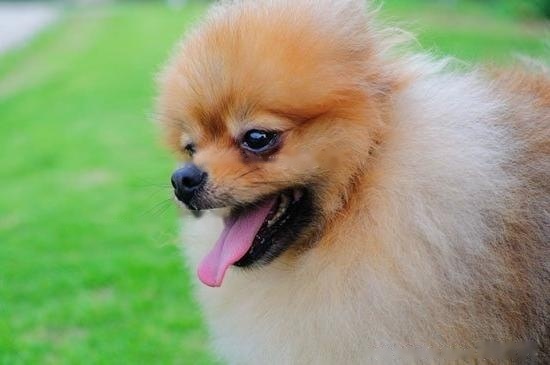Pomeranian is a compact, short-backed, active toy dog. He has a soft, bushy undercoat and a coarse coat. The base of the tail is set high and the thickly feathered tail rests flat on the back. He has a vigilant disposition, a clever expression, a brisk demeanor and a curious nature. Pomeranian's gait is proud, solemn and lively. His temperament and actions are healthy.

[body size]
The weight range of a Pomeranian is 3-7 lbs. The ideal weight is 4 to 6 pounds. Any dog under or over this weight is not welcome. In any case, overall quality is more important than size. Body length (length from shoulder to hip) is slightly less than height at withers, and the distance from chest to floor is equal to half the height at withers. Bone is medium and the length of the legs is in balance with the body structure. To the touch, it should feel solid.
[head]
The head is in proportion to the body, the muzzle is short, straight, and refined, allowing the mouth to open freely without being rude. The expression is vigilant, it can be said that it is a bit like a fox. Skull close together, skull slightly rounded, but not arched. When viewed from the front or side, small ears set high and erect can be seen. If you imagine a line from the tip of the nose through the middle of the eyes and the tip of the ears, you can see that Pomeranian's head is wedge-shaped. The eyes are dark, bright, medium in size and almond shaped. They are flanked by prominent stops on the skull. Pomeranians have black noses and eye rims, except for brown, beaver and blue Pomeranians that match their own coat color. Scissor bite. One missing tooth is acceptable. Major defects: too round, arched skull; prominent upper jaw; prominent lower jaw.
[neck, topline, body]
The neck is short, meeting the shoulders just enough to hold the head high. The back is short and the topline is level. The body is compact, with well-spread ribs and chest deep to the elbows. One of the characteristics of this breed is the feathered tail, which lies flat on the back.
[Forequarter]
The Pomeranian's shoulders are set back enough to allow the neck and head to be lifted high. The shoulders and legs are moderately muscular. The length of the shoulder blade is equal to that of the upper arm. The front legs are straight and parallel to each other. The length from the elbow to the withers is roughly equal to the length from the elbow to the ground. The wrists are straight and strong. Feet are arched and compact, turning neither in nor out. Toenails stretched forward. Dewclaws can be removed. Major flaw: Low ankle.
[hindquarters]
The hind legs and hips are at the right angle to the hindquarters. The rump is well positioned behind the tail. The thigh muscles are moderately developed, and the rear knee joint is moderately inclined, forming a clear outline. The hocks are perpendicular to the ground, the leg bones are straight, and the hind legs are parallel to each other. Feet are arched and compact, turning neither in nor out. Toenails stretched forward. If the hind legs have dewclaws, they can be removed. Major Defect: Lack of stable support structure in the bovine limb or hind leg or hind knee joint.
[coat]
The Pomeranian has a double coat with a soft, bushy undercoat. The coat is long, straight, shiny and coarse in texture. The thick undercoat supports the outer coat, allowing it to stand upright on the Pomeranian's body. The neck, front of the shoulders and chest are densely covered, forming a decoration on the shoulders and chest. The coat on the head and legs is shorter than on the rest of the body and fits snugly against the body. The forelegs are feathered to the ankles, and the tail is covered with long, coarse, scattered and straight coats. Trimming to keep the outline clean and tidy is permitted. Major flaws: Coat is soft, flat and thin.
[color]
All colors, patterns, variations are accepted and treated equally. Pattern: Brown and Brown - Clear brown or rust markings on the top of the eyes, muzzle, throat and forechest, legs and paws and behind the tail. More brown is ideal; spots: the basic color is gold, red or orange spots, which are not satisfied with black cross markings; color matching: white with other color markings, with white tendons on the head is ideal. Classification: In professional competition, colors are divided into several categories: red category includes red, orange, cream and sable; black category includes black, brown and blue; other color category includes any other color and pattern or variation .
[GAIT]
The Pomeranian's gait is smooth, relaxed, harmonious and lively. Good forequarter guidance and strong rear drive. The back leg on each side moves in the same line as the front leg. Legs converge slightly toward the centerline of the body for balance. The front and rear legs are turned neither in nor out, the topline is level and the overall profile is balanced.
[temperament]
The Pomeranian is an outgoing, very intelligent and lively dog, making it an excellent companion dog, as well as Very competitive racing dog.
Standard adoption date: December 9, 1996
Standard implementation date: January 31, 1997
![[Dog Training 5] The training method of pet dog dining etiquette](/static/img/12192/12192_1.jpg)




